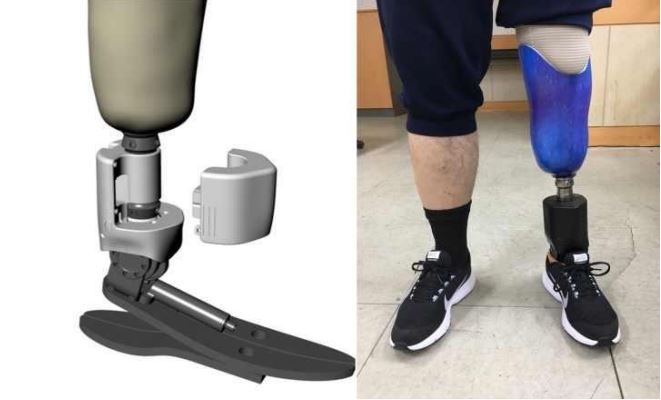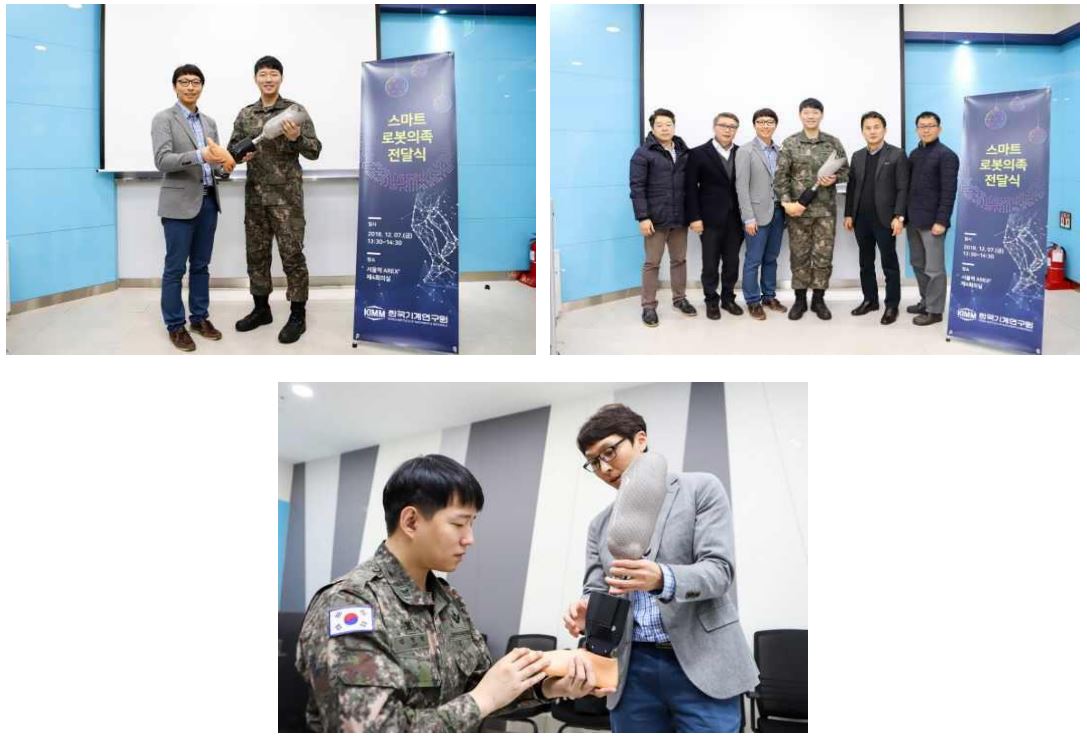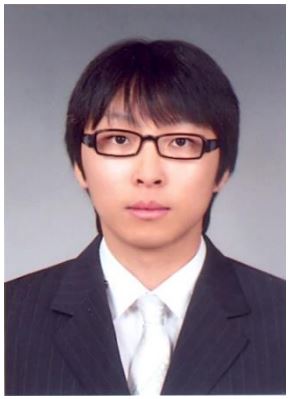
- Created2018.12.10
Wounded While Defending Nation – Walking Again Thanks to New MachineTechnology
-KIMM establishes an INNOPOLIS Research Institute Spin-off Company, ‘Ohdae Inc.’,
for successful commercialization of asmart robotic prosthesis
-New prosthesis delivered to Sgt. 1stClass Jung WonKim,
who lost his ankle froma landmine explosion during service
The Korea Institute of Machinery and Materials (KIMM, President Chun Hong Park) has brought mobility back to a veteran with the help of a new development in medical machinery. Dr. Hyun Soo Woo, head of the department, and his research team at KIMM’s Daegu Research Center for Medical Devices and Green Energy successfully developed and commercialized a Smart Robotic Prosthesis with the establishment of an INNOPOLIS Research Institute Spin-off Company* , Ohdae Inc. The team decided to deliver their very first commercial prosthesis to Sergeant First Class Jung Won Kim, who lost his right ankle from a land-mine explosion during his service.
*An INNOPOLIS Research institute spin-off company refers to an enterprise established by a legally qualified body (public research institute, industry-academe cooperation technology holding company, etc.) within an INNOPOLIS to commercialize its technology. It shall be registered according to the Special R&D Zone Act (https://www.innopolis.or.kr/eng_sub0302)In April of last year, Dr. Woo’s research team developed the Smart Robotic Prosthesis technology. However, soon after the development they faced the limitations of a poor domestic prosthesis environment and in response the team decided to establish their own spin-off Company: Ohdae Inc.
The Smart Robotic Prosthesis is a product that simulates similar movement of a human ankle and the natural ground reaction force to reduce pain and fatigue when wearing the prosthesis.
What makes this development even more impressive is that the research team decided to present its very first commercialized product to Sergeant First Class Jung Won Kim. Just before the final commercialization, the team analyzed the gait pattern of Mr. Kim for two months with the help of the Armed Forces Medical Command and produced an optimized prosthesis for him. On the day of the first trial with Mr. Kim wearing the Smart Robotic Prosthesis, with only one hour of practice he was able to walk without any other walking aids.
Commenting on how it feels to wear the prosthesis, Mr. Kim, who participated in clinical trials since October, said, “This newly developed Smart Robotic prosthesis feels just like a real leg.”
After succeeding in developing this prosthetic technology in April last year, the research team established Ohdae Inc. and started working on commercialization. The weight of the new prosthesis is only about 1 kg, 0.45 kg lighter than the previous prosthesis. Along with this, the torque for ground reaction force has been increased up to 150Nm, putting it on par with the torque output level of the existing globally leading prosthesis product. On top of this, the price of the product has been decreased to a quarter of that of the foreign products.
Another outstanding aspect of this product is its creative design at the ankle part. At the ankle, the motor part is combined with a spring. This not only reduces the total weight but also allows the product to operate more safely if a power-breakdown emergency occurs. Once fully charged, this prosthesis can operate for a maximum of four hours without any change of battery, and a battery change is also possible if needed. When connected with the smartphone app, the user can check the remaining battery life, or can switch between different operation modes.
Currently, only foreign robotic prostheses are sold in the market, and the price is around USD 88,000 (KRW 100 million). Moreover, in order to actually equip a foreign robotic prosthesis, several months of analysis of the user‘s gait pattern is required. These factors have made access to robotic prostheses extremely difficult for ordinary domestic consumers.
This research outcome is more meaningful because it was an accomplishment created from cooperation between various institutions, such as Chungnam National University Hospital (co-research and technical exchanges in the clinical trials), the Armed Forces Medical Command, and Korean Society for Prosthetics and Orthotics.
Dr. Woo noted, “After a year-long effort, finally we were able to develop and commercialize a domestic robotic prosthesis that has the same quality as the world’s best product.” He also added, “With the help of this new development, I hope that numerous domestic disabled people, who could not afford a robotic prosthesis until now, can enjoy the benefits and live an active life just as in foreign countries.”
Attachments (Large-size photos will be sent separately): - Attachment 1: Smart Robotic Prosthesis (Photo)
- Attachment 2: Photos of SFC Kim with the New Prosthesis
- Attachment 3: Q&A for the Research
- Attachment 4: Resume of the Lead Researcher (Dr. Woo)
- Attachment 1: Smart Robotic Prosthesis (Photo)

Photo: The concept art of the new Smart Robotic Prosthesis (left) successfully developed/commercialized by Dr. Hyun Soo Woo and his team (Department of Medical Assistant Robot at KIMM’s Daegu Research Center for Medical Devices and Green Energy), and the actual photo of the product (right).
- Attachment 2: Photos of SFC Kim with the New Prosthesis

Photo: (Top-left) KIMM’s Dr. Hyun Soo Woo (left) hands over their very first Robotic Prosthesis to SFC Jung Won Kim (right), who lost hisright ankle in a land-mine explosion during his service, at the Presentation Ceremony on Friday, December 7. (Top-right) KIMM’s Dr. Woo and his research team (Department of Medical Assistant Robot at KIMM’s Daegu Research Center for Medical Devices and Green Energy), along with the Ohdae Inc. personnel posing with SFC Kim at the Ceremony. (Bottom) SFC Kim and Dr. Woo talking about the new Robotic Prosthesis. SFC Kim had actively and willingly participated in the development process, providing practical insights on the necessary improvements of the product from the perspective of an actual user.
- Attachment 3: Q&A for the Research
| What is the difference between this and the previous development? | “With the robotic prosthesis developed in 2017 as the basis, we were able to commercialize the smart robotic prosthesis through various clinical trials, improvements, and tests for user-friendliness.” |
| Where can this product be used? | “This product can assist walking as well as daily routines of lower limb amputees.” |
| How long did it take to commercialize? | “Through the establishment of Ohdae Inc., it only took about a year to successfully commercialize it.” |
| What made you start researching this project? | “During the development stage of the robotic prosthesis from 2015 to 2017, many lower limb amputees who participated in the trials hoped for the commercialization of this product so that they would be able to use it in their daily life as soon as possible. To meet their wishes, we began to work on commercialization right away.” |
| What is the goal of this project? | “We hope that this commercialized smart robotic prosthesis can be supplied and used by many lower limb amputees inside and outside of the country.” |
Attachment 4: Resume of the Lead Researcher (Dr. Woo)

1. Personal Info ○ Name: Hyun Soo Woo
○ Affiliation: Department of Medical Assistant Robot, Daegu Research Center for Medical Devices and Green Energy, Korea Institute of Machinery & Materials
○ Contact: +82-53-670-9019 / +82-10-6434-****
○ E-mail: [email protected]
2. Education ○ 2009 KAIST Doctoral Degree in Mechanical Engineering
○ 2002 KAIST
Master’s Degree in Mechanical Engineering
○ 2000 KAIST Bachelor’s Degree in Mechanical Engineering
3. Employment History ○ 2010~Present Principal Researcher at Korea Institute of Machinery & Materials
○ 2009~2010 Post-Doctoral Fellow at KAIST Mechanical Technology Research Institute
4. Professional Experience ○ 10 Patents and seven pending patents for development of Rehabilitation Robot and Remote Surgical Robot
○ Three robot related technology transfers (Development of light-weight, high efficiency unified actuator module, Development of unified actuator module controller, Development of ROS based collaborative robot)
○ Awarded one of ‘100 Technologies/People that will lead Korea’s Industries in 2020’ (2013. Dec. 19, presented by the National Academy of Engineering of Korea)



